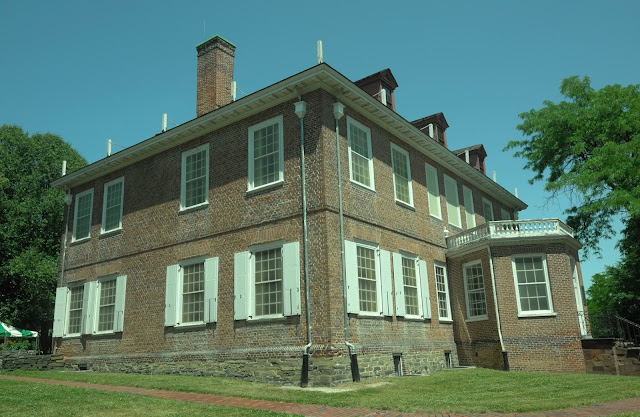 |
| Patton, West Point, NY |
General Patton, the American Mars, declared that "Fixed fortifications are a monument to the stupidity of man." But Patton was surely a maverick among the American military where a defensive focus has been a part of our history from our founding as a nation. The preamble to the US Constitution explicitly suggests that the federal government will "provide for the common defense". Fortifications have played a role in our nation's defense over many years.
 |
| Fort Ticonderoga, NY |
The legendary Fort Ticonderoga (
http://www.fortticonderoga.org/) was initially built by the French as Fort Carillon in 1755 at the start of the Seven Years War. The French hoped to defend New France from the British colonies to their south that greatly outnumbered them in terms of population.
 |
| Benedict Arnold, St. Mary's Battersea, London |
Ticonderoga, the Gibraltar of the North, would be captured and recaptured many times over its history. On May 10, 1775, for example, Ethan Allen and
Benedict Arnold captured Fort Ticonderoga in upstate New York. When the British commander asked by whose
authority they acted Arnold thundered, “in the name of the Great Jehovah and
the Continental Congress.” Fifty-eight
mortar and cannon seized at Ticonderoga would later be dragged by forces led by
Henry Knox (a portly Boston bookseller) to Dorchester heights in Boston where
they would be used to drive the British from that city. (For more on Benedict Arnold see...
http://americanconservativeinlondon.blogspot.com/2016/05/st-marys-battersea-benedict-arnold.html)
 |
| Soldiers firing muskets, Fort Ticonderoga, NY |
The successful capture of Ticonderoga by Gentleman Johnny Burgoyne at the open of the Saratoga campaign is a perfect illustration of Patton's pointed criticism. In 1777, the year of the Hangman, Burgoyne marched an Army of 7,000 south from Canada in order to cut the American rebel forces in two isolating New England. Outnumbered American forces led by General St. Clair withdrew from Ticonderoga without firing a shot. General Schuyler was dismissed by the Continental Congress for this disgraceful loss. But, in fact, Fort Ticonderoga proved to be a trap for Burgoyne who went on the lose battles at Bennington and in the woods near Saratoga before surrendering his command of
5,895 men on October 17, 1777. Saratoga marked the turning point of the American Revolution.
 |
| French Castle, Fort Niagara, NY |
Fort Niagara (
http://www.oldfortniagara.org/) in Western New York was initially built in order to protect New France. At its heart lies the "French Castle". The Americans in Fort Niagara and the British in Fort George would trade canon fire across the Niagara river in the summer of 1812. On the evening of December 18, 1813 Colonel John Murray and 550 British soldiers crept towards Fort Niagara. A group of American guards were caught while playing cards and forced to divulge the fort’s password. The sleeping garrison was captured at bayonet point. It was to be the last foreign assault on an American military installation on the mainland until the Japanese attack on Fort Stevens in 1942.
 |
| Fort Clatsop, OR |
Fort Clatsop (
www.nps.gov/lecl/learn/historyculture/fort-clatsop.htm) near Astoria, Oregon, though merely a stockade, is one of the most significant Forts in American History for this is the end of the Lewis and Clark trail. After an arduous journey Lewis and Clark arrived on the northwest coast of Oregon and constructed Fort Clatsop where they stayed from November 1805 until mid March 1806. It rained every day. They dined mainly on elk. The expedition interacted with the Clatsops, Chinooks, Killamucks, Cathlahmahs, and Wackiacums that Lewis described as being “loquacious and inquisitive.” They purchased fish and other items from the Indians. Lewis described the local natives as having “copper brown” complexions and complained that they were “illy shapen”. But evidently not all members of the corps of discovery agreed or cared about Lewis’ judgement -- mercury was used to treat the venereal disease that private Silas Goodrich picked up from “amorous contact with a Chinnook damsel”.
 |
| Fort Ross, CA |
Fort Ross (
http://www.fortross.org/) in Northern California, a few miles North of the Russian River, was not built by Americans at all. It was an imperial outpost of Czarist Russia from its founding in 1812 until its sale to John Sutter (of Gold Rush fame) in 1841. The Russians landed in what is today Sonoma county seeking to establish a warm weather agricultural and trading center that would help to feed its colony in Alaska. Its guns were never fired in anger.
 |
| Russell Battery, Fort Stevens, OR |
Fort Stevens (
www.nps.gov/places/fort-stevens.htm) in Oregon near the mouth of the Columbia was built during the US Civil War in order to prevent Confederate raiders from preying on shipping along the river and the Oregon coast. On the evening of June 21, 1942 Commander Tagami of the Imperial Japanese navy sailed his I-25 submarine offshore near Fort Stevens, Oregon. Seventeen rounds were fired from his 140mm deck gun from 20,000 yards. No one was killed or injured and little damage was done in the bombardment. The antiquated Fort’s armament had a range of only 16,200 yards and could not return fire. The sub slunk off before American Army Air Force planes could respond. It was the first attack on a US Army installation in the continental United States by a foreign power since the War of 1812 when Fort Niagara was attacked by the British. The attack did help to fuel anti-Japanese hysteria on the West coast that contributed to the internment of Japanese Americans.
 |
| Fort Casey, Whidbey Island, WA |
And, finally, we come to Fort Casey (
http://parks.state.wa.us/505/Fort-Casey) in my home state of Washington. This Fort is a perfect illustration of why Patton condemned the stupidity of fixed fortifications. Construction of this Fort began in 1897. Fort Casey, located on Whidbey Island, enjoys sweeping views of Admiralty Inlet. Its purpose was to protect the Northwest from invasion or naval attack. Its potential enemies might have been Japanese, Russian or even British but none would ever test Casey's guns. Around the time Fort Casey was completed in 1903 its mission had already been rendered obsolete with the invention of human flight that same year. Fort Casey was a US military facility in two World Wars but its bug guns were never fired in anger. Today defense of the Northwest is secured by nearby Whidbey Island naval air station and other defense establishments such as Fort Lewis / McChord (See...
http://americanconservativeinlondon.blogspot.com/2014/08/fort-lewis-museum.html).
 |
| Sea Lions off Fort Casey State Park, WA |
All the taxpayer monies spent of Fort Casey were not, however, a waste. Fort Casey is today a beautiful Washington State Park. It remains a wonderful spot to take in the views, see sea lions and enjoy a picnic.
You can find signed copies of
You can find signed copies of Italy Invades: How Italians Conquered the World here...www.italyinvades.com




















































